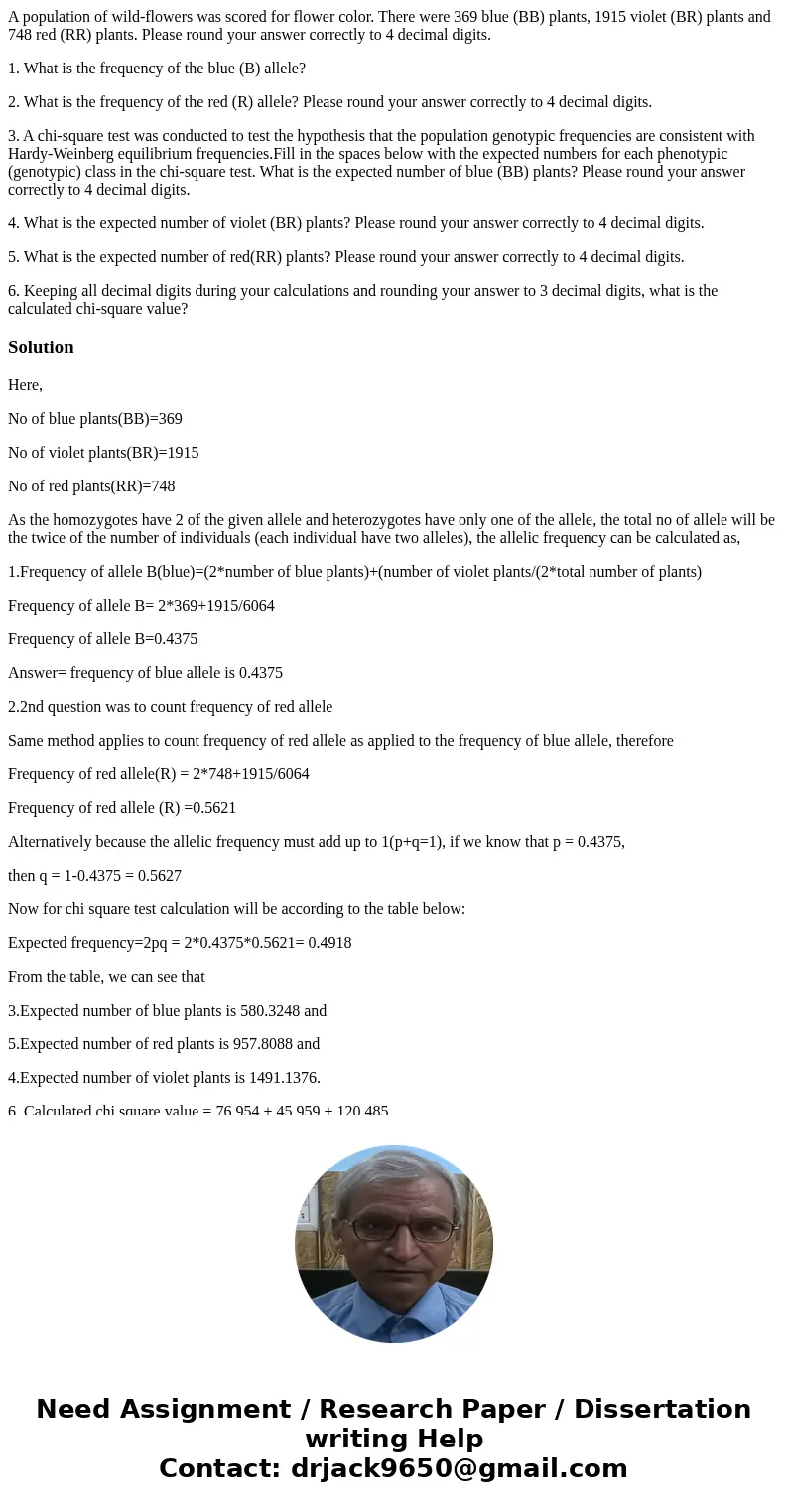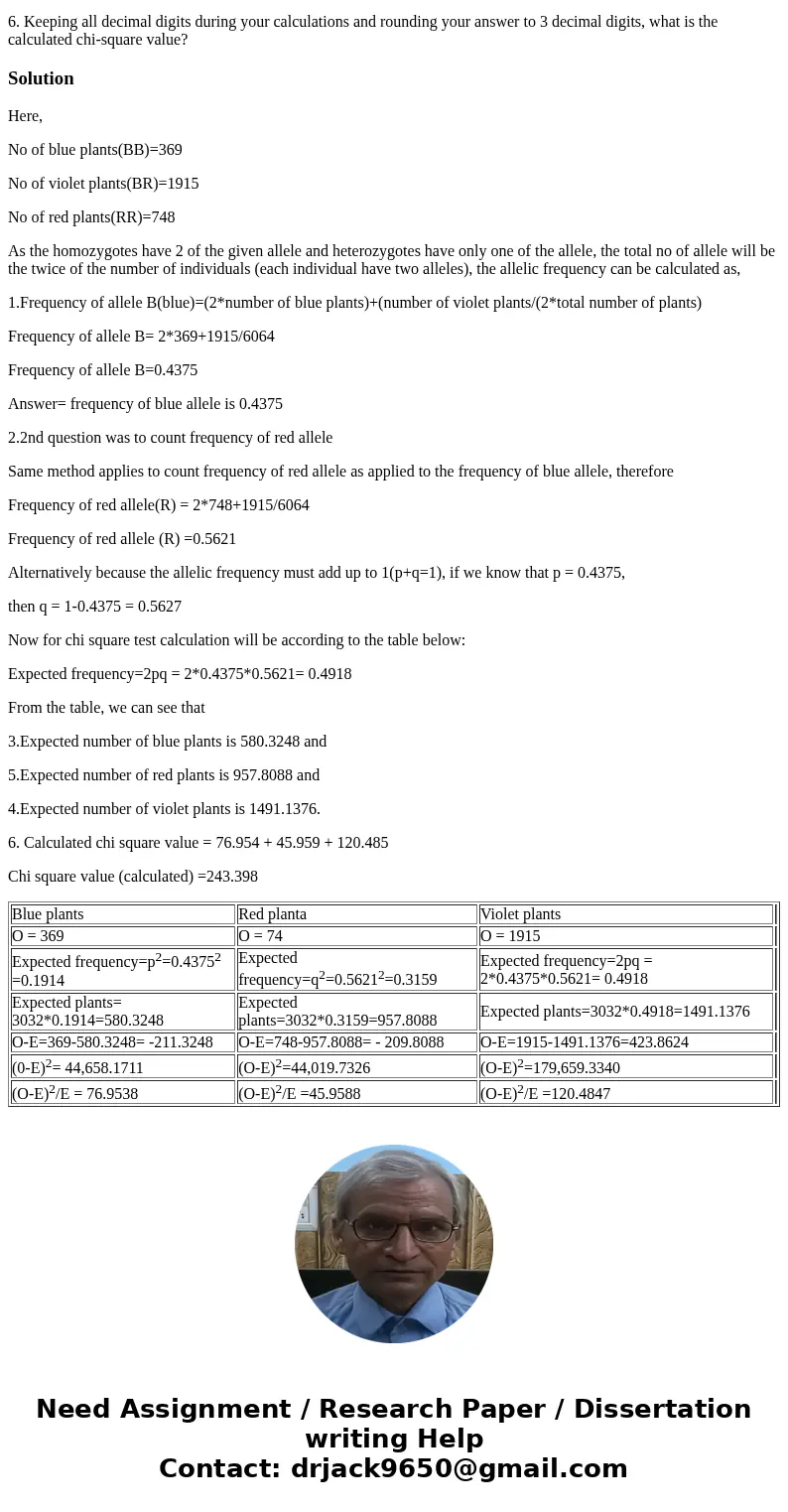A population of wildflowers was scored for flower color Ther
A population of wild-flowers was scored for flower color. There were 369 blue (BB) plants, 1915 violet (BR) plants and 748 red (RR) plants. Please round your answer correctly to 4 decimal digits.
1. What is the frequency of the blue (B) allele?
2. What is the frequency of the red (R) allele? Please round your answer correctly to 4 decimal digits.
3. A chi-square test was conducted to test the hypothesis that the population genotypic frequencies are consistent with Hardy-Weinberg equilibrium frequencies.Fill in the spaces below with the expected numbers for each phenotypic (genotypic) class in the chi-square test. What is the expected number of blue (BB) plants? Please round your answer correctly to 4 decimal digits.
4. What is the expected number of violet (BR) plants? Please round your answer correctly to 4 decimal digits.
5. What is the expected number of red(RR) plants? Please round your answer correctly to 4 decimal digits.
6. Keeping all decimal digits during your calculations and rounding your answer to 3 decimal digits, what is the calculated chi-square value?
Solution
Here,
No of blue plants(BB)=369
No of violet plants(BR)=1915
No of red plants(RR)=748
As the homozygotes have 2 of the given allele and heterozygotes have only one of the allele, the total no of allele will be the twice of the number of individuals (each individual have two alleles), the allelic frequency can be calculated as,
1.Frequency of allele B(blue)=(2*number of blue plants)+(number of violet plants/(2*total number of plants)
Frequency of allele B= 2*369+1915/6064
Frequency of allele B=0.4375
Answer= frequency of blue allele is 0.4375
2.2nd question was to count frequency of red allele
Same method applies to count frequency of red allele as applied to the frequency of blue allele, therefore
Frequency of red allele(R) = 2*748+1915/6064
Frequency of red allele (R) =0.5621
Alternatively because the allelic frequency must add up to 1(p+q=1), if we know that p = 0.4375,
then q = 1-0.4375 = 0.5627
Now for chi square test calculation will be according to the table below:
Expected frequency=2pq = 2*0.4375*0.5621= 0.4918
From the table, we can see that
3.Expected number of blue plants is 580.3248 and
5.Expected number of red plants is 957.8088 and
4.Expected number of violet plants is 1491.1376.
6. Calculated chi square value = 76.954 + 45.959 + 120.485
Chi square value (calculated) =243.398
| Blue plants | Red planta | Violet plants | |
| O = 369 | O = 74 | O = 1915 | |
| Expected frequency=p2=0.43752 =0.1914 | Expected frequency=q2=0.56212=0.3159 | Expected frequency=2pq = 2*0.4375*0.5621= 0.4918 | |
| Expected plants= 3032*0.1914=580.3248 | Expected plants=3032*0.3159=957.8088 | Expected plants=3032*0.4918=1491.1376 | |
| O-E=369-580.3248= -211.3248 | O-E=748-957.8088= - 209.8088 | O-E=1915-1491.1376=423.8624 | |
| (0-E)2= 44,658.1711 | (O-E)2=44,019.7326 | (O-E)2=179,659.3340 | |
| (O-E)2/E = 76.9538 | (O-E)2/E =45.9588 | (O-E)2/E =120.4847 |


 Homework Sourse
Homework Sourse